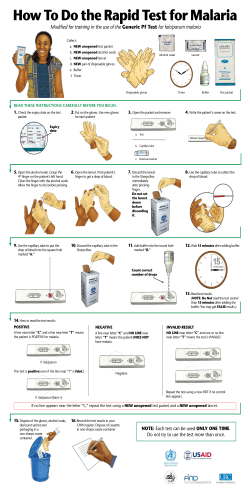
Document 268831
SDS-PROTEIN CALIBRATION for Capillary Electrophoresis Kit No. SDS-PRO-CE January KIT Technical Bulletin No. SDS-PCK1 1994 I NTRODUCTION This kit is designed for separation of SDS-protein complexes using a non-gel sieving mechanism to determine molecular weights and protein purity on capillary electrophoresis units. The sieving range is 14,000-205,000. Items Provided: (Sufficient for approximately 300 runs, J1§m Product SDS-Protein Standards for Capillary Electrophoresis M 2789 3.5 mg SDS-Protein Separation Medium for Capillary Electrophoresis M 6664 50 ml s 9788 10 ml w 4253 100 ml O 9007 SDS-2X Sample Buffer for Capillary Electrophoresis SDS-Washing Solution Orange G Solution-lnternal Standard for Capillary Electrophoresis Technical Bulletin No. SDS-PCK1 Technical Bulletin No. SDS-PCK1 No. Amount Sml A. Protocol for Preparing SDS-Protein Standards Protein Samples for Capillary Electrophoresis 1. 2. and Unknown SDS-Protein Standards a. Reconstitute the SDS-Protein Standards (Product No. M 2789) with 750111of SDS-2X Sample Buffer (Product No. S 9788) and 750111of deionized water. Vortex to assure the proteins are completely dissolved. Aliquot and freeze unused portions of solution at -20°C or below. b. To 100 111of reconstituted SDS-Protein Standards from Step 1.a., add 3 111of Orange G Solution-lnternal Standard (Product No. O 9007) and 2.5111of 2-Mercaptoethanol (Product No. M 7154, not provided in kit). c. Boil the Protein Standards from Step 1.b. for 5 minutes. the solution has cooled before applying to a capillary. Wait until Protein Sample a. Prepare protein sample(s) at a concentration of 0.2-1.0 mg/ml for each individual protein in the solution. The total protein concentration should not exceed 7 mg/ml. b. Mix the sample solution prepared in Step 2.a. in a ratio of 1 :1 (v/v) with SDS-2X Sample Buffer (Product No. S 9788). c. To 100 ,ul of the sample solution prepared in Step 2.b., add 3,u1 of Orange G Solution-lnternal Standard (Product No. O 9007) and 2.5 ,ul of 2-Mercaptoethanol (Product No. M 7154, not provided in kit). d. Notes: Boil the sample solution prepared in Step 2.c. for 5 minutes. it has cooled, apply to a capillary . 1. 2. 3. 2 After Salt concentrations must be below 50 mM for electrophoretic injection and below 200 mM for pressure injection. Do not use any potassium salts since they will precipitate with SDS. Omit the 2-Mercaptoethanol if the sample will be run under non-reducing conditions. Technical Bulletin No. SDS-PCK1 B. Running Conditions 1 SDS-Protein Separation Medium (Product No. M 6664) and SDS-Washing Solution (Product No. W 4253) should be degassed before use. 2. Follow manufacturer's 3. For an electrophoretic load use 10 kV for 20 seconds. use 5 psi for 12 seconds. 4. Run for 30 minutes at 15 kV constant voltage, negative to positive polarity , at a temperature of 20°C on a coated capillary (50 J.1mx 36 cm). 5. Detection System: turer's instructions. 6. Purge Cycles: instructions to assemble the capillary to be used. For a pressure load Use 214 nm at 0.02-0.05 AUFS or follow manufac- To prepare capillary prior to starting run: Purge: 5 10 minutes with deionized water minutes with SDS-Protein Separation (Product No. M 6664) M e d iu m Before each sample application: 2 Purge: 3 0 minutes w 4253) minutes (Product seconds with SDS-Washing minutes minutes (Product minutes minutes with with No. with with Solution(prodld with SDS-Protein Separation No. M 6664) with deionized water (3X) No. M e di u m After completion of run: Purge: 2 3.5 2 3 Technical Bulletin No. SDS-PCK1 deionized water SDS-Washing Solution W 4253) deionized water dry nitrogen gas 3 c. T able Molecular Weight Standards (Product Determinations of Unknown using SDS-Protein No. M 2789) 1 Calculate the migration time for each protein in SDS-Protein Standards by subtracting the retention time of the internal standard (Orange G) from the retention time of each protein standard. 2. Plot the migration time for each protein standard vs. its molecular weight (See Table A) on semi-Iogarithm graph paper to obtain a linear standard curve. 3. Calculate the migration time for an unknown protein by subtracting the retention time for the internal standard (Orange G) from the retention time for the unknown protein. 4. Estimate the molecular weight of the unknown protein from the standard curve plotted in Step 2. A. Subunit Molecular Weights of Proteins Contained in SDS-Protein Standards for Capillary Electrophoresis (Product No. M 2789) SUBUNIT MOLECULAR WEIGHT PROTEIN a.-Lactalbumin, Bovine Milk 14,200 Trypsin 20, Inhibitor. Soybean 100 Carbonic Anhydrase, Bovine Erythrocyte 29,000 Ovalbumin, Chicken Egg 45,000 Albumin, Bovine Serum 66,000 Phosphorylase b, Rabbit Muscle 97 ,400 coli 116,000 Myosin, Rabbit Muscle 205,000 ~-Galactosidase, 4 Proteins E. Technical Bulletin No. SDS-PCK1 Figure 1. Typical Electropherogram of SDS-Protein Calibration Standards using BioRad BioFocus 3000. 1) a-Lactalbumin, Bovine Milk; 2) Trypsin Inhibitor, Soybean; 3) Carbonic Anhydrase, Bovine Erythrocyte; 4) Ovalbumin, Chicken Egg; 5) Albumin, Bovine Serum; 6) Phosphorylase b, Rabbit Muscle; 7) ~-Galactosidase, E. co/~ 8) Myosin, Rabbit Muscle. 3 0.00 Technical Bulletin No. SDS-PCK1 6.00 12.00 18.00 24.00 30.00 5
© Copyright 2025







![I [Tools & Techniques]](http://cdn1.abcdocz.com/store/data/000283946_1-eed87a24a1e1770271ec5d58315043af-250x500.png)













